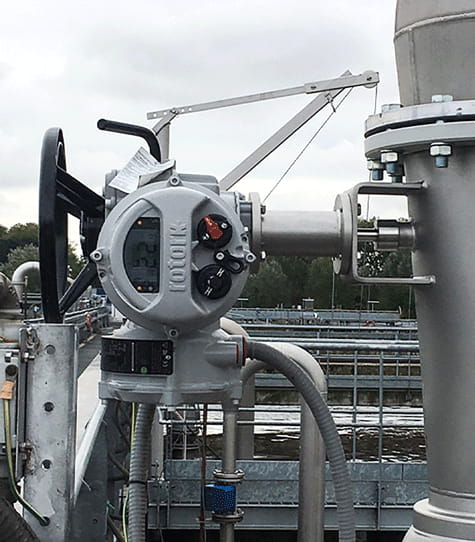
Wastewater is a catch-all term to describe water that has been used in a process. This includes industrial wastewater (generated from a wide variety of industrial applications like manufacturing and power generation), runoff water (excess rain and melt water) and domestic wastewater (sewage). Wastewater must be treated to ensure it is safe for reuse. If wastewater does not go through a treatment process, it will retain high levels of pollutants and bacteria. Water becomes cleaner and safer as it travels through the various wastewater treatment processes. Treated water is safe and clean and discharged back into the environment, ensuring the continued safe functioning of wildlife habitats, recreation sites, rivers and oceans or for use in applications like agriculture and industry. It allays health concerns of reusing water in all these contexts. It is part of a circular and more sustainable economy.
Safety Considerations in Automation of Valves
The wastewater industry is actuator-intensive; flow control equipment is commonly used on wastewater sites, providing reliable and safe control at multiple stages. Valve actuators make a contribution to the efficiency of modern wastewater treatment processes via remote control and facilitating automation. A central principle of flow control is that actuators provide automation of otherwise manual operations. In applications that once required engineers to physically open and close valves, actuators automate the process and offer increased reliability, efficiency and safety. For example, a Danish wastewater treatment works upgraded from manual to automated valve actuation with electric actuators. The treatment plant on the Danish Island of Lolland treats approximately 2.8 million cubic meters (m³) of wastewater before being discharged into the Smålandsfarvandet (a body of water connecting Storebælt in the west with Storstrømmen and Guldborgsund in the east that serves as a waterway for coastal traffic, yachts and other small craft). This automation means control of the penstocks and gate valves is safer and more reliable.
Additional safety features are sometimes chosen within wastewater applications. Innovation in flow control technology means that engineers can now safely control actuators in remote or inaccessible locations on wastewater sites (these sites are often automated or operated by minimal numbers of staff). For example, a sewage treatment plant in Australia chose intelligent multi-turn electric actuators to operate penstock valves, using a valve actuator for extra safety enhancement. The site treats sewage before it is reused or discharged into rivers or oceans. The penstocks had previously been accessed via a ladder and manually operated, which took four people six hours to fully open or close the valve. Automation meant that this vital work could be undertaken more safely and efficiently. The valve actuator chosen allows for safe local monitoring in difficult-to-access or hazardous locations. It is possible to operate remotely, interrogate and configure the actuator from up to 100 meters (m) away, meaning operators on site no longer need to be close to it in awkward conditions. At a water treatment plant in Kansas, actuators were installed on butterfly valves beneath a walkway. Valve actuators eliminated problems with access and ensured that operators could work safely. Safe operation must always be considered of paramount importance in wastewater applications.
Robust Operation at Wastewater Treatment Stages
There are many different stages in wastewater treatment that require specialist flow control. At all points, actuators must offer high durability and reliability, as they will be routinely exposed to extreme weather and temperature conditions. They will likely need Ingress Protection (IP) 68 certification to ensure there is no water ingress. For example, actuators were installed on several water treatment plants in New Zealand. This installation was an upgrade from previously unreliable pneumatic actuators. The new actuators operate at filtration and chemical dosing stages and were chosen because of the damp, chlorinated atmospheres they needed to operate in. This operation is an example of the multiple roles that actuators can play on wastewater sites. They are also found in the inlet, screening, aeration, settlement, sludge and chemical/ultraviolet stages.
Irrigation & Other Wastewater Use
Irrigation is an everyday use for treated wastewater. Water scarcity is an increasing concern in many places worldwide, so the safe use of wastewater is a sensible way to provide essential water for irrigation in agriculture. It is a system of safely recycling water to meet the vital needs of a growing population. Ensuring that wastewater used for irrigation is safe must always be a primary concern; as with all wastewater applications, flow control plays a crucial role in these processes. For example, intelligent electric actuators operate jet valves at a water treatment plant in Milan, Italy, that treats wastewater for irrigation purposes. The wider Lombardy area of Italy increasingly suffers periods of drought. Therefore, the use of treated water for irrigation is greatly needed and plays an essential role in the sustainable management of Italian agriculture. The Milano San Rocco Wastewater Treatment Plant processes the wastewater of a population of over one million people, which equates to an average flow of 3 cubic meters per second (m3/s). The water undergoes an overall ultraviolet disinfection process. The actuators on jet valves provide critical air regulation by controlling the air inlet in the oxidation tanks. These tanks contain essential microorganisms to process any harmful elements in the water; the precise control offered by intelligent actuators is critical.
Wastewater can be used for various industrial uses, such as manufacturing, concrete and cooling water for power plants and oil refineries. It can also become potable water.
Water scarcity is an increasing problem amid the climate crisis and a growing population. Effective water management is essential. One way of wisely using all water sources is treating and reusing wastewater in diverse applications, including irrigation and manufacturing. Flow control plays a central role in wastewater applications, and actuators control water flow at multiple stages, offering safe and reliable management.

